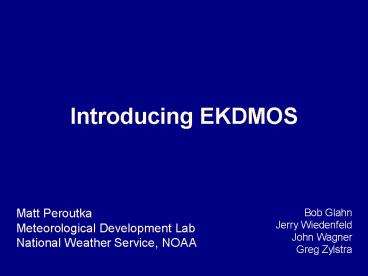Introducing EKDMOS PowerPoint PPT Presentation
Title: Introducing EKDMOS
1
Introducing EKDMOS
- Matt Peroutka
- Meteorological Development Lab
- National Weather Service, NOAA
Bob Glahn Jerry Wiedenfeld John Wagner Greg
Zylstra
2
Ensemble Kernel Density MOS (EKDMOS)
- Probabilistic forecast guidance for
- Temperature (T), dew point (Td), daytime maximum
temperature (MaxT), nighttime minimum temperature
(MinT). - 13 probability levels (0.05, 0.10, 0.20, 0.25,
0.30, 0.40, 0.50, 0.60, 0.70, 0.75, 0.80, 0.90,
0.95). - NDGD grids.
- Days 1-8 x 3-h (T/Td). Days 1-16 x 24-h
(MaxT/MinT).
3
PDFs for a Single Event
4
EKDMOS Method
- Use screening multiple regression with the NCEP's
GEFS ensemble means, - Estimate error variance directly from the
regression, - Apply equations to individual ensemble members
and combine results with Kernel Density fitting - Gausian kernel
- Standard deviation produced by the regression
- Apply a spread adjustment based on the spread of
the ensemble members.
5
EKDMOS Method
Development
Error Variance
Ensemble Means
Regression
Observations
Predictive Equation
Implementation
Forecast
Kernel Density Fitting
Spread Adjustment
Ensemble Members
Probability Distribution
6
Regression Framework
- Regression estimates Y as a function of X, sample
of size n. - Lines at probability level a can be placed with t
distribution - Yh(new) new value of Y found from a new value
of X, Xh - MSE error sum of squares divided by degrees of
freedom - r multiple correlation coefficient
- s standard deviation of the predictand
- Summations are taken over the n sample cases
7
Regression Equation and Prediction Intervals
8
Kernel Density Fitting
- Forecasts are combined with Kernel Density
Fitting, using a Gausian kernel and the standard
deviation produced by the regression.
9
EKDMOS Spread Adjustment
x ratio of new width to old width
10
Evaluation
- Tools
- Probability Integral Transform (PIT) Histograms
- Square Bias (SB)
- Cumulative Reliability Diagram (CRD)
- Continuous Ranked Probability Score (CRPS)
- Baseline for Comparison
- Raw Ensembles
- Operational Ensemble MOS
11
Baseline Reliability
OpnlEnsMOS
OpnlEnsMOS
Raw Ens
Raw Ens
Day2
Day5
Day7
12
EKDMOS Dep. and Ind. Data
Dep
Dep
Ind
Ind
Day2
Day5
Day7
13
EKDMOS Ind. Dew Point, Daytime MaxT, Nighttime
MinT
Dew Point
MinT
MaxT
Day2
Day5
Day7
14
Baseline Reliability/Accuracy
15
Visualization--Grids
- NDGD grid projections
- 13 probability levels available only 3 shown
here.
0.50
0.10
0.90
16
Meteograms
- Uses 3 probability levels (0.10, 0.50, 0.90)
- Time series of forecast values
- Mullin Pass, Idaho (KMLP)
17
"Wings of Uncertainty"
18
"Wings of Uncertainty"
- Image is median of distribution.
- Length of wings shows degree of cold and warm
uncertainty
19
"Wings of Uncertainty"
- Image is median of distribution.
- Length of wings shows degree of cold and warm
uncertainty - Black stripes shown at 5 deg F intervals from 50
value - Black wing tips show cold or warm skew in
uncertainty
20
Conclusions
- Developed method for making MOS forecasts from
ensembles for quasi-normally distributed
variables. - Regression applied to NCEP ensemble means.
- KDE, normal kernel, mean and standard deviation
from regression. - Spread Adjustment.
- Reliable and Robust.
- Can be implemented in NDGD.
- (E.g., temperatures as probability levels on the
CDF)
21
Introducing EKDMOS

